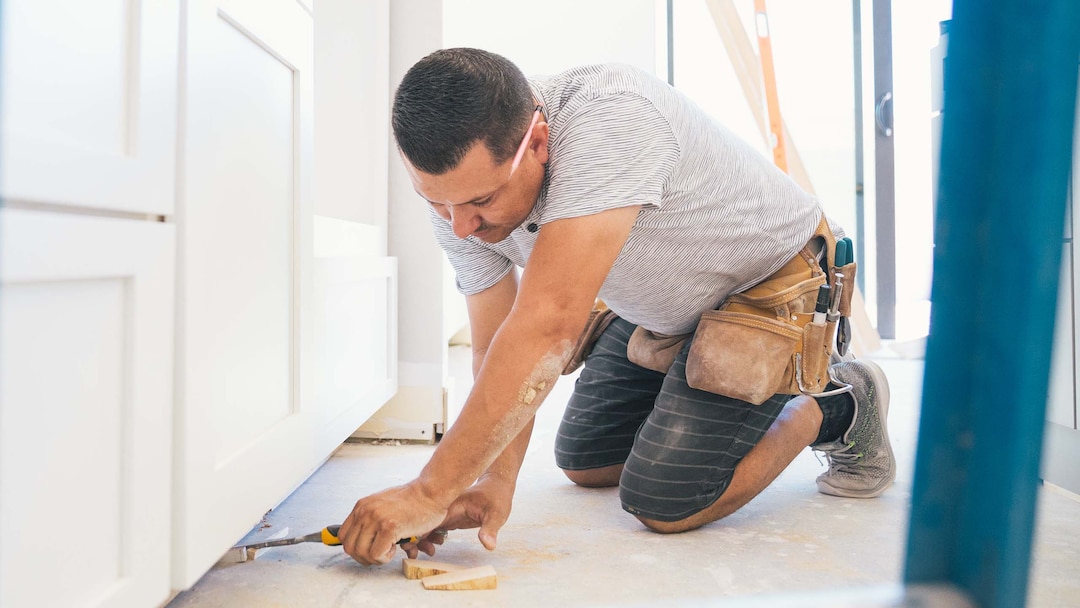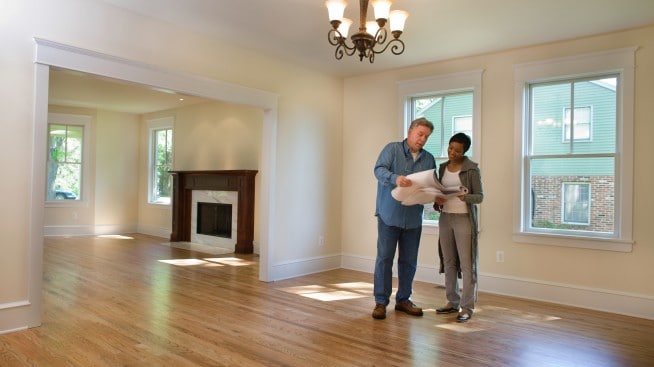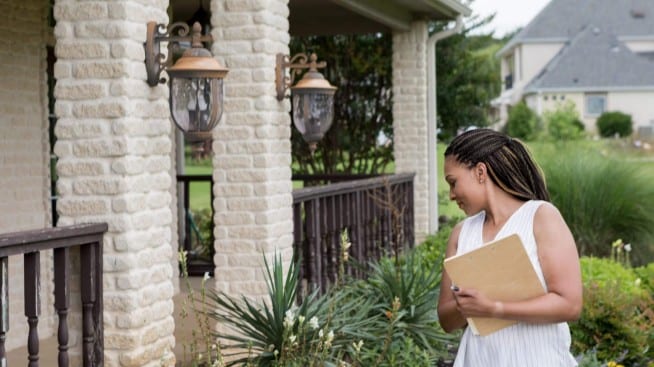When to walk away after a home inspection

The home inspection process is an integral part of your homebuying journey, one that may clue you in to the flaws of your dream home. Understanding the home's issues may allow you to negotiate with the seller and could even reveal problems that indicate you shouldn’t buy the property at all. But how exactly do you know when to walk away after a home inspection? To better understand your options, let’s take a closer look at how home inspections work, common issues that may turn up and the problems that might turn out to be deal breakers.
What is a home inspection and how does it work?
A home inspection helps assess a property’s condition. It can be an illuminating process that demystifies the repairs and renovations the home might need before you sign a contract.
To start, you’ll want to hire an inspector. This professional will examine the physical property and its mechanical components before compiling the findings into a detailed report. This documentation will shed light on any work the home may need. From there, homebuyers can decide whether to negotiate the price, request repairs or home renovations, or choose to avoid the purchase altogether.
Home inspection checklist
A home inspection will typically assess the state of several home features, from the exterior and grounds to utilities like plumbing and electric. Here’s what is generally included in a home inspection checklist:
- Exteriors and grounds: Inspectors typically look over the structure's foundation, the grounds and landscaping, siding, walls, windows and doors. They’ll generally be keeping an eye out for any damage, decay, signs of leaks and, in the case of windows and doors, any issues with functionality.
- Interior: Home inspectors will assess the interior structure and fixtures of the home, which includes walls, flooring, windows, doors and ceilings. They’ll be looking for signs of water damage, any uneven surfaces, and the condition of countertops and cabinets, as well as any performance issues with appliances and interior doors.
- Kitchens and bathrooms: Issues with proper ventilation and water damage are most typical in these areas and will be discussed in the inspection report.
- Safety features: Common home safety features such as smoke detectors, carbon monoxide detectors, fire extinguishers and sprinklers will usually be examined during the home inspection process.
- Electric: A home’s electrical, plumbing and HVAC systems are crucial for its functionality. Because of this, a home inspection will assess any potential leaks, your water pressure, water heater and any wiring issues to make sure everything is functioning as it should be.
- Inspection report: Finally, your inspector will draw up a report that lays out any problems they observed. From there, you’ll decide how you want to proceed.
Common home inspection issues
Before we go into when you might want to walk away after an inspection, let’s go over some of the more common home inspection issues your inspector might uncover, and how they might be remedied with home repairs.
- Minor plumbing issues: Leaky faucets, running toilets and minor drainage issues are frequently revealed in a home inspection, but are relatively inexpensive and quick fixes if you hire a professional.
- Peeling paint: The cosmetic issue of peeling paint is something that can be quickly remedied with a new paint job.
- Small-scale pest infestations: Some minor pest infestations can be dealt with by a few visits from an exterminator.
- Furnace issues: While some furnace problems may require a full replacement, some furnaces will work more efficiently after a maintenance call with a licensed technician.
- Caulking and sealing: Sometimes a home inspection will reveal the need for recaulking and sealing areas around windows, doors and bathrooms. Handy homeowners may be able to do this work on their own, while others may want to hire a contractor.
- Minor roof repair: If the rest of the roof is in good condition, issues such as missing or damaged shingles can often be remedied with individual replacement rather than overhauling the whole roof.
- Minor mold and mildew: If certain mold or mildew cases are relegated to a small area and pose minimal risk to your health, it may be possible to clean and treat the zone to avoid future growth.
- Outdated electrical outlets: If your electrical outlets aren’t up to date, replacing them with newer, safer outlets is generally a relatively quick, safe and simple task if you hire an electrician.
When to walk away from a house after inspection
While some home inspection issues won’t necessarily warrant rethinking a purchase, others, like health hazards or costly repairs are a bit riskier. If the inspection precedes any purchase agreement, or you have an inspection contingency, these dealbreakers may be enough for you to walk away:
- Health hazards: If a home inspection uncovers health hazards such as asbestos, lead paint or other toxic substances, you may want to rethink your purchase. These findings can lead to serious health issues for the home’s inhabitants and could involve costly, time-consuming repairs that, depending on your situation, may not be worth it.
- Infestations: While some infestations may be relatively simple to take care of, others may pose a greater risk to your home’s structure and safety or may involve higher repair costs and a greater investment of time. The presence of wood-destroying termites or carpenter ants, for example, could mean the home’s structural integrity has been compromised. If the home has a particularly rampant rodent infestation, the critters could chew through insulation or wiring, which could lead to costly repairs or hazardous conditions, not to mention risk of disease.
- Water damage: Water damage is often tied to underlying issues like plumbing problems, a faulty, leaky roof and recurrent floods or drainage issues. This means you’ll likely need to tackle both the damage and the source, which could be an involved process. Additionally, if the damage is widespread or has been growing over time, it could lead to mold, rot or structural issues that could be challenging to remedy.
- Structural damage: Issues with the home’s foundation, its walls, or roof could compromise its stability and safety. Repairing severe flaws such as cracks in the foundation, sagging walls or a faulty roof could be an expensive, time-consuming process.
- Electrical or mechanical problems: Faulty or malfunctioning mechanical systems could, at best, mean issues with comfort and functionality, and at worst, indicate serious safety issues. Even seemingly minor electrical or mechanical problems require a licensed professional's assistance and could involve a lengthy, costly repair process.
- Mold: Similarly to water damage, the presence of mold often denotes larger issues with the home such as leaks or poor ventilation. Mold can lead to allergies and respiratory issues, sometimes causing severe health issues for sensitive individuals. Because of this, and the potential for lengthy, costly remediation, some homeowners might consider walking away from a home with widespread or stubborn mold growth.
Negotiating after a home inspection
In situations where the issues are more commonplace and fixable, you may want to try negotiating with the seller. Here’s what that process might look like:
- Review the inspection report: Before you jump into negotiations, consider reviewing the report a few times to familiarize yourself with which issues are major and which might be remedied more easily.
- Prioritize: Once you have a handle on the scope of the inspection’s findings, you may want to prioritize the concerns that pose as health hazards or may require costly, ongoing repairs.
- Get estimates: If there are significant issues, you may want to get estimates from contractors or other repair services. This will give you a better idea of the costs involved with fixing the issues, and which issues you might feel comfortable covering.
- Decide if you want to negotiate: Depending on the inspection results and estimates, you’ll want to figure out what you think the seller should do. You could ask them to make the repairs or renovations themselves, offer you a credit to cover a portion of the closing costs or reduce the price of the home.
- Draft a repair request and submit to seller: Once you’ve decided on your ideal outcome, you’ll want to draw up a formal document with a detailed description of the issues and the desired remedies. The request will then be submitted to the seller or their agent, which they may then accept, reject or counter.
- Consider a compromise: Depending on their response, you may need to compromise with the seller. If you’re set on buying the home, try to identify issues you may be more flexible about to help you find a middle ground.
What if the seller isn’t willing to negotiate?
Seller not willing to negotiate after inspection? While disappointing, there are still some options to consider:
- Reassess your priorities: If there are major issues with the home, you may want to walk away from your purchase. However, if the issues are on the minor side, you may feel comfortable making concessions and taking care of them yourself.
- Consider a home warranty: If the seller is unwilling to negotiate, consider suggesting the inclusion of a home warranty in the sale. Home warranties may offer you protection by covering certain costs for a specified time.
- Walk away: If you’re not feeling flexible, or if a home warranty is rejected, you may have to look for a new home with less problems. It may not feel great, but you may be saving yourself from a potentially expensive, unhealthy and time-consuming situation.
In summary
Buying a home is a big decision, and you’ll likely want to know what you’re getting into before you commit. Home inspections help identify potentially hazardous or expensive issues with a property, giving you a better idea of what you’re signing up for and the kind of work you may have to put into the house to make it a safe, comfortable environment as well as a sound investment.
While not all home inspection findings are dealbreakers, if the home needs extensive, costly repairs, or has issues that pose health risks, it may be time to look for another dream home. If you’re still unsure of when to walk away after a home inspection or simply want more information, reach out to your real estate agent or attorney. They should be able to provide you with guidance that’s tailored to your specific situation.
When to walk away after home inspection: FAQs
1. How often do buyers back out after home inspection?
It’s hard to pinpoint exactly how many buyers back out from a purchase after home inspection, but in 2022 as many as 15% of home purchase agreements fell through. It’s possible that some of them had to do with inspection findings.
2. How long after home inspection is closing?
Every home purchase is different. As the timeline of the sale depends on what is found in the home inspection and how you decide to approach the findings, the time between the inspection and closing may vary.
3. What happens if the previous owners did unpermitted work?
If the home’s previous owners did unpermitted work you can either take responsibility for the work or try to negotiate. Keep in mind that after you buy the home you’ll need to address and resolve the permit issues or inform prospective buyers if you decide to sell.



